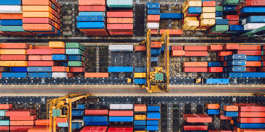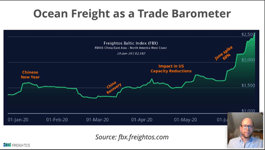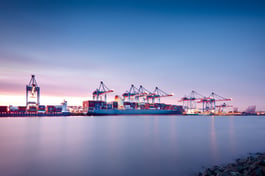TradeLanes supports emerging leaders in global trade with mentorship and a platform to connect and share their perspective with our audience of global trade leaders. This month's blog is written by Nairoby Asprilla, an emerging leader in logistics and global trade enthusiast based in Panama. She currently works in an NVOCC which offers exclusive LCL NEUTRAL services to Freight Forwarders, in sales trading and governance. I am interested in researching existing logistics industry problems to analyze them and provide my insights and recommendations.
This blog post is the author’s viewpoint on the important issue of container availability.
“In Asia, we are noticing rates three times higher than the normal high-season of previous years. For our business, one of the routes that have risen the most during this crisis is Ningbo to The Dominican Republic. As of now, we have seen an increment on this route of up to $10,000 per 40-foot container. This trend will probably continue incrementing after the Chinese New Year.”
CEO Phillippe Fiore, NVOCC Pier17 Group.
The shortage of containers has world trade flow in jeopardy. There are just not enough empty containers available to load cargo in Asia - and equipment is not making it to rural areas (like the Midwest US) to get cargo to Asia. Meanwhile, piles of empty boxes are sitting at ports and depots. Shippers, freight forwarders, carriers, ports, and other players suffer the consequences of this situation since last year, but what’s really going on from my perspective?
Analysis
The rebound of China’s economic activities during the pandemic has caused an acceleration of exports from Asia to satisfy the peak demand for goods in North America, Europe, South America, and elsewhere leading to an imbalance in trade flow. Given a result of hundreds of thousands of containers sat at ports and depots in the occidental hemisphere. Moreover, the slow empty reposition of boxes from American Ports has also intensified this problem, as carriers do not want to return empty containers to Asia due to the extra costs involved. On the other hand, exports from the western hemisphere have been held due to the coronavirus restrictions and lockdowns. Therefore, it has made China’s exports surge at a faster pace making it reach record levels. According to an article published by the China Macro Economy, in November, China has had an accelerated export haul increment of 21.1% from a year earlier. Even though tariffs, trade tensions, and COVID-19 has been a constant challenge for China’s exports trade during 2020.
With the poor records of empty containers in China, the outlook of global trade looks uncertain. On the report of container availability index released by Container xChange, it is stated that 40-foot High Cube availability in Shanghai is only 0.05 points, compared to 0.63 points of last year. A number lower than 0.5 points indicates a shortage of equipment. This empty container crisis is directly impacting shippers and shipping lines. U.S. agricultural exporters are drastically affected as well. Some lines have decided not to place containers into interior agrarian areas. Moreover, some shipping lines (Maersk, Hapag Lloyd, MSC) have been presenting longer blank-sailing and delays on their schedules. They are even skipping certain North American ports causing vessel space shortages. All this started happening when the pandemic began, but it rose since last October, when China’s Golden Week started, resulting in more cargo rolled over demurrage and detention charges.
Consequences
This disruption has created much frustration in terms of profitability and just-in-time (JIT) delivery. It has also aggravated other existing vulnerabilities the global shipping industry has been struggling with, such as inconsistent freight rates and empty repositioning. Regarding profitability, the outlook is not the most uplifting for shippers, which claim that freight rates should not rise opportunistically. Even in hard times, Carriers’ companies always expect to make money, so they try to manage the business in a way that allows them to make as much profit as possible, impacting the tariffs and rates given to NVOCCs and Freight Forwarders. As a result, container freight rates have been skyrocketing in the last months, and they are expected to continue rising due to the container crunch and their robust demand. As reported by the Shanghai Container Freight Index (SCFI), rates in Northern Europe and the Mediterranean rose to 21% to 23%, respectively, in November last year.
Meanwhile, according to the Freightos Baltic Daily Index, the transpacific lanes have presented a rate increment of 32.5% in the Asia-West Coast and a 48.3% in the Asia-East Coast route since June. “In Asia, we are noticing rates three times higher than the normal high-season of previous years. For our business, one of the routes that have risen the most during this crisis is Ningbo to The Dominican Republic. As of now, we have seen an increment on this route of up to $10,000 per 40-foot container. This trend will probably continue incrementing after the Chinese New Year” CEO Phillippe Fiore, NVOCC Pier17 Group.
Concerning JIT, in November 2020, Sea Intelligence published its Global Liner Performance Report, which stated that the average global carrier schedule reliability of 34 trade-lanes fell 50.1%. It is the worst global score recorded since 2011. Also, on-time arrivals were down to 28.6% in the Asia-West Coast trade and 26.4% in the Asia-East Coast trade. As a result, they are causing significant issues because thousands of empty containers are piling up in ports and depots in the U.S. while there is a shortage of empty boxes to load in China. This situation has been exacerbated by the long periods these empty boxes have been sitting in the U.S. On average empty containers spend 45 days in depots, but sometimes it could be longer, reaching 61 to 66 days.
Recommendations:
2020 has exposed some of the weaknesses and inefficiencies in the global supply chain. Resiliency and dealing with global trade effectively is about preparedness and responsiveness during crisis times.Here are five suggestions that can help your business to cope with present and future disruptions.
- Keep your team up to date. Educating your company staff with the latest information about the industry is crucial in these challenging times. Currently, shipping lines send announcements of their schedule changes on their main lanes, specifically Transpacific networks starting in January 2021, so keep your team updated.
- Anticipate with accurate forecasts and projections. Precise predictions are a great ally when navigating uncharted waters. They allow companies to prepare better for challenging scenarios. Trusted companies, as Container Xchange can provide reliable prediction insights.
- Rely on technology. New advanced technologies are crucial for creating resiliency in your supply chain. Seek software packages that aggregate visibility and market data to make better decisions. Access to continuous and real-time data is key to understanding container demand patterns to avoid being scrambling for container space. Also, up-to-date technology will ease the management of the day-to-day operations.
- Be straightforward. Have open and transparent communication with your clients and explain the situation accordingly; make them understand the reasons behind the freight rates increment worldwide.
- Post-Mortem. The pandemic plus the container shortage has created upheaval in the global shipping market. But let's not forget that most businesses have been struggling for years prior. During and after this crisis, analysis, evaluation to develop contingency plans to mitigate risks, and to analyze the lessons learned and adopt best practices.
What is your organization doing to navigate through this crisis and upcoming ones? Is your team ready to cope with the Chinese New Year challenges? Please feel free to share your thoughts on this matter with us!




Leave a Comment